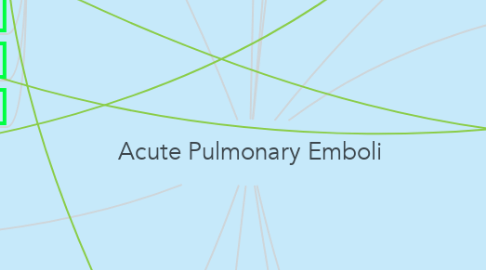
1. Leads to Death
2. Pathophysiology
2.1. Leads to Obstructive Shock
2.2. Pulmonary Occlusion leads to Increased Right Ventricular After Load
2.2.1. Causes Tricuspid Valve (TV) Insufficiency
2.2.2. Causes Increased Right Ventricular (RV) (Wall Tension
2.2.3. Neurohormonal Activation
2.2.4. Myocardial Inflammation
2.2.5. Increased RV O2 Demand
2.2.6. Intrapulmonary A-V Shunting
2.2.7. RV ischemia, hypoxic injury
2.2.8. Decreased RV Contractility
2.2.9. Decreased RV Output
2.2.10. Decreased LV Preload
2.2.11. Decreased Cardiac Output
2.2.12. Decreased Systemic Blood Pressure
2.2.13. Decreased Coronary Perfusion of RV
2.2.14. Decreased RV O2 Delivery
3. Diagnostic Tests
3.1. D-dimer
3.2. CTA
3.3. V/Q lung scan
3.4. ECG
3.5. US
3.6. Pulmonary Embolism Severity Index (PESI)
3.7. Troponin
3.8. N-Terminal pro brain natriuretic peptide (NT-proBNP)
4. Pertinent Positives
4.1. Rales or crackles
4.2. Family and Social Hx
4.3. Coagulopathy
4.4. Decreased Mobility
4.5. Current Malignancy
4.6. Recent long trip
4.7. Smoker
5. Health Promotion
5.1. Chronic Treatment and prevention of recurrence
5.1.1. Assessment of VTE recurrence risk
5.1.2. Anticoagulant-related bleeding risk
5.1.3. Regimens and tx durations with non-vitamin K antagonist coagulants and antithrombotic drugs
5.1.4. Management of PE in CA patients
5.1.5. Management of PE in Pregnancy
6. Signs and Symptoms
6.1. Pleuritic Chest Pain
6.2. Dyspnea
6.3. Tachypnea
6.4. Hypoxia
6.5. Cough (possibly blood-tinged sputum
6.6. Tachycardia
6.7. Dizziness or syncope
6.8. Hypotension/Shock with Massive PE
6.9. Recent symptoms indicating DVT
7. Strong Risk Factors
7.1. Lower Limb Fracture
7.2. Previous Venous Thrombus Embolism (VTE)
7.3. Hospitalization for MI, Heart Failure or Atrial Fibrillation - in last 3 months
7.4. Hip or Knee Replacement
7.5. Major Trauma
7.6. Spinal Cord Injury
7.7. Previous VTE
8. Education
8.1. Management of Coagulopathy
8.2. Public Awareness of Risks and Symptoms
8.3. Promotion of Movement, Compression Stockings for long trips
8.4. Hydration
8.5. Smoking Cessation
8.6. Diet and Exercise
9. Moderate Risk Factors
9.1. Arthroscopic Knee Surgery
9.2. Autoimmune Disease
9.3. Blood Transfusion
9.4. Central Venous Lines
9.5. Intravenous Catheters and Leads
9.6. Chemotherapy
9.7. Congestive Heart Failure or Respiratory Failure
9.8. Erythropoiesis-stimulating Agents
9.9. Hormone Replacement Therapy
9.10. In Vitro Fertilization
9.11. Oral Contraceptive Use
9.12. Post-Partum Period
9.13. Infection (specifically pneumonia, urinary tract infection (UTI) and HIV
9.14. Inflammatory Bowel Disease
9.15. Cancer (highest risk in metastatic disease
9.16. Paralytic Stroke
9.17. Superficial Venous Thrombus
9.18. Thrombophilia
10. Weak Risk Factors
10.1. Bed rest > 3 days
10.2. Diabetes mellitus
10.3. Arterial Hypertension
10.4. Immobility Due to Sitting (e.g. prolonged car or air travel)
10.5. Increasing age
10.6. Laparoscopic Surgery
10.7. Obesity
10.8. Pregnancy
10.9. Varicose Veins
11. Evidence Based Practic
11.1. Hemodynamic and Respiratory Support
11.1.1. Oxygen Therapy and Respiratory Suppor
11.1.2. Mechanical Circulatory Support and Oxygenation (ECMO)
11.1.3. ACLS
11.2. Initial Anticoagulation
11.2.1. Parenteral anticoagulation
11.2.1.1. Pharmacological Tx of acute RV failure
11.2.2. Non-Vitamin K antagonist oral anticoagulants
11.2.3. Vitamin K antagonists
11.3. Reperfusion Treatment
11.3.1. Systemic Throbolysis
11.3.2. Percutaneous Catheter-Directed Treatment
11.3.3. Surgical Embolectomy

